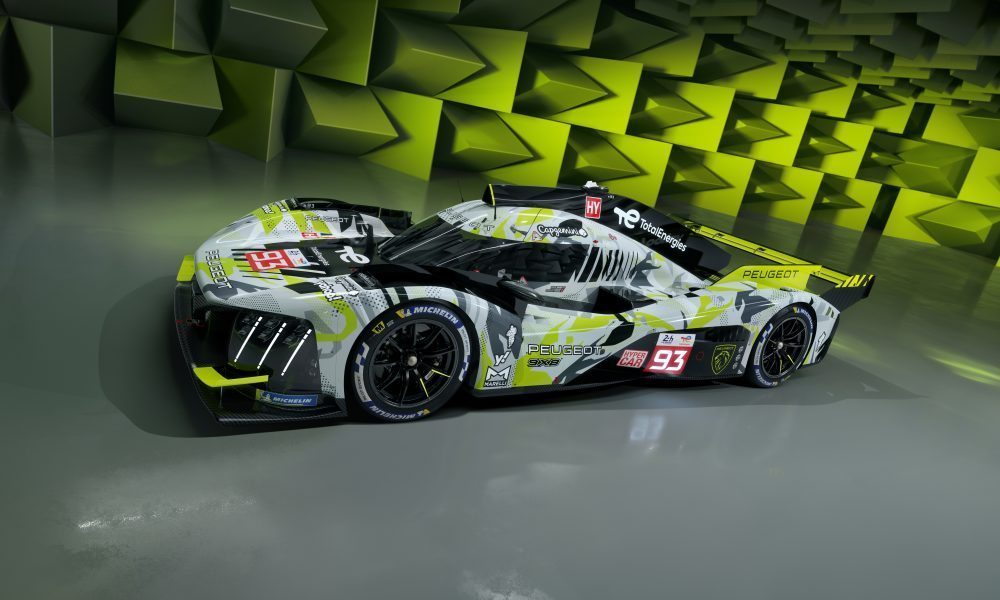Peugeot TotalEnergies has formally revealed their 2024-spec 9X8 FIA WEC Hypercar ahead of its race debut at the 6 Hours of Imola next month.
The new 9X8, which features an entirely overhauled aerodynamic concept that includes a rear wing, replaces the evolved first iteration of the car which first appeared towards the end of the 2022 FIA WEC season.
The first-gen 9X8 featured an unconventional design that relied on its ability to generate the bulk of its downforce through its underfloor.
The car though had limited success during its time as Peugeot’s top-class WEC challenger and was plagued by both performance and reliability issues.
In addition to its aerodynamic improvements, Peugeot also hopes to benefit from new tire sizes for the car. The previous model used 31cm wide front and rear tyres and will switch to utilising 29cm front, 34cm rear tyres, which has become the standard in Hypercar. 90 perecent of the original bodywork has been redesigned and there have been other reliability-based changes too, including more built-in resilience in both the gearbox and the engine.
The high point for the car came at the 6 Hours of Monza last July when it finished on the podium. Other highlights included leading a substantial chunk of the 2023 Le Mans 24 Hours and the 2024 FIA WEC season-opening 1812km race in Qatar.

“We made choices that are no longer relevant today and this performance gap has not been sufficiently compensated by the BoP (Balance of Performance) in 2023,” explained Olivier Jansonnie, technical director of Peugeot Sport.
“The idea was therefore to return to a choice of car concept much closer to what our competitors are doing, so as to then be balanced in an equivalent manner by the BoP. Hence in particular the abandonment of the fitting of 31/31cm square tires, to instead adopt rubber measuring 29cm in size at the front and 34cm at the rear.
“It is not strictly speaking a new car, because the entire chassis part has been preserved, but there are a lot of developments. To make the tires work properly, it was necessary to modify the center of gravity of the Peugeot 9X8, therefore moving parts, also working on weight reductions… And to have a well-balanced aerodynamic balance, we also reviewed the distribution of forces. aerodynamics, which led us to redesign around 90% of the bodywork elements, including the grafting of a rear wing.
“In addition to that, we took advantage of this new approval to include a certain number of reliability and performance developments to put all the chances on our side.”
Peugeot now confirm that they began work on the redesign as early as March 2023, and first revealed to RACER last July ahead of the race in Monza that it was evaluating substantial upgrades for the 2024 season. The new car began track testing late last year.
With the FIA and ACO working to ensure that Hypercar manufacturers don’t bring upgrades that disrupt the Balance of Performance process that is employed to allow LMH and LMDh cars to compete with one another, the Hypercar homologation process and the need to test proved to be lengthy obstacles. The new car was not available for the opening round of the 2024 Championship in Qatar, with Peugeot opting to delay its debut to Imola in April.
Even prior to the development of the 2024-spec 9X8, Peugeot had made significant strides with the original model to make it more reliable. This included a switch from a gearbox which shifted electronically to a new one that was hydraulically activated. However, the tweaks made during the second half of the 2023 season via more minor updates were not significant enough to make the car consistently competitive and Peugeot decided that a substantial update was necessary.
LMH cars, unlike LMDh cars, can benefit from up to five performance-related ‘Joker’ upgrades during their lifespan (reliability and safety-focused tweaks do not count towards the five), but the process is far from straightforward. Peugeot have not yet confirmed how many of these ‘Jokers’ have been used to enable the 2024 car to be fielded.
